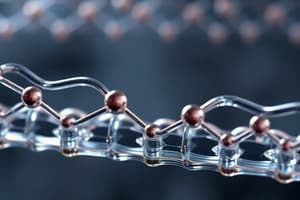Podcast
Questions and Answers
Define amphipathic.
Define amphipathic.
A molecule that has both a hydrophilic region and a hydrophobic region.
Describe the structure of a phospholipid.
Describe the structure of a phospholipid.
There is one head made up of glycerol linked to phosphorous and there are two carbon-hydrogen chains.
What parts of the phospholipids are hydrophobic and hydrophilic?
What parts of the phospholipids are hydrophobic and hydrophilic?
The head is hydrophilic and the two tails are hydrophobic.
Define hydrophobic.
Define hydrophobic.
Define hydrophilic.
Define hydrophilic.
How do phospholipids react to water?
How do phospholipids react to water?
Describe the phospholipid bilayer.
Describe the phospholipid bilayer.
Why is the fluid mosaic model used to describe how the cell membrane works?
Why is the fluid mosaic model used to describe how the cell membrane works?
Name the two primary things that make up the cell membrane as well as their function.
Name the two primary things that make up the cell membrane as well as their function.
Name some other things in the cell membrane.
Name some other things in the cell membrane.
Name the watery fluid on either side of the cell membrane.
Name the watery fluid on either side of the cell membrane.
How is cholesterol important to the phospholipids?
How is cholesterol important to the phospholipids?
How do molecules without a charge get into and out of the cell?
How do molecules without a charge get into and out of the cell?
How do very large molecules or molecules with a charge get into the cell?
How do very large molecules or molecules with a charge get into the cell?
What four types of proteins are in the cell membrane and what are their functions?
What four types of proteins are in the cell membrane and what are their functions?
What is the major 'take home message' of section 3.5?
What is the major 'take home message' of section 3.5?
Flashcards are hidden until you start studying
Study Notes
Key Definitions
- Amphipathic: Molecules possessing both a hydrophilic (water-attracting) region and a hydrophobic (water-repelling) region.
- Hydrophobic: Molecules that repel water, generally nonpolar substances that do not dissolve in water.
- Hydrophilic: Molecules that are attracted to water, readily absorbing or dissolving, characterized as polar.
Phospholipid Structure
- Basic Composition: Contains one hydrophilic head (glycerol linked to phosphorous) and two hydrophobic carbon-hydrogen tails.
- Hydrophobic and Hydrophilic Regions: The head is hydrophilic, while the two tails are hydrophobic.
Phospholipid Behavior in Water
- Reaction to Water: The hydrophilic heads orient toward water, while the hydrophobic tails orient away from it.
- Phospholipid Bilayer: Formed from two layers of phospholipids with heads facing outwards towards the watery environments and tails creating an inner barrier.
Cell Membrane Model
- Fluid Mosaic Model: Describes the dynamic nature of the cell membrane, which consists of various components that move within the lipid bilayer.
Composition of Cell Membrane
- Primary Components:
- Phospholipids: Maintain fluidity and structural integrity of the membrane.
- Proteins: Provide specific functions, such as transport and communication across the membrane.
Additional Membrane Structure
- Other Components:
- Glycoproteins: Proteins with sugar groups that serve as cell recognition molecules.
- Glycolipids: Lipids with sugar groups that play a role in cell recognition.
- Cholesterol: Helps maintain membrane fluidity by preventing the fatty acid tails of phospholipids from sticking together or drifting too far apart.
Transport Mechanisms
- Diffusion: Process by which uncharged molecules pass freely through the membrane.
- Proteins for Large or Charged Molecules: Utilize specific proteins to facilitate entry or exit, such as aquaporins for water.
Types of Membrane Proteins
- Receptor Proteins: Bind extracellular molecules to regulate cellular processes.
- Recognition Proteins: Identify cells as self to prevent immune attacks.
- Transport Proteins: Allow passage of large or charged molecules.
- Enzymatic Proteins: Catalyze chemical reactions within the cell.
Summary of 3.5
- The cell membrane is a universal component of all cells, characterized by its fluid nature and composition primarily of phospholipids and proteins.
Studying That Suits You
Use AI to generate personalized quizzes and flashcards to suit your learning preferences.




